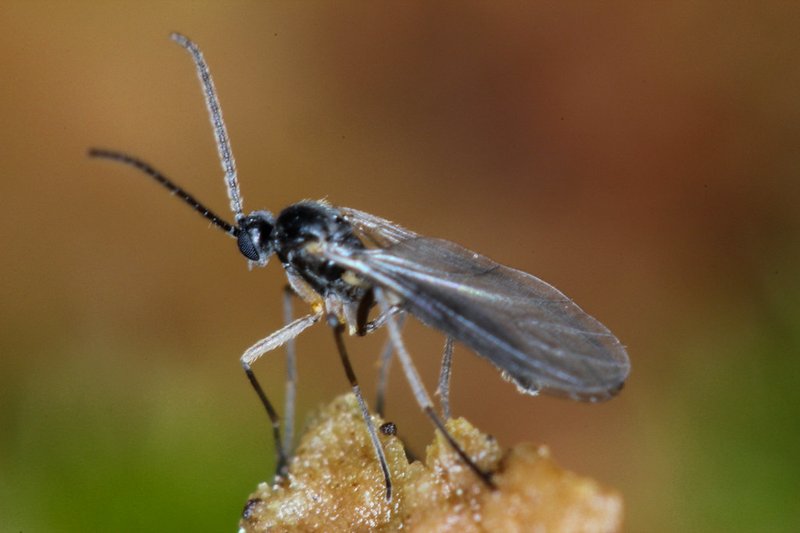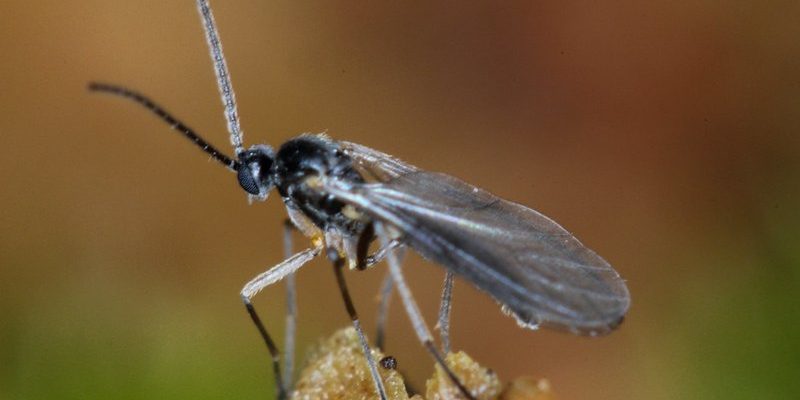
Picture this: you’re in your cozy home, surrounded by beautiful plants, and suddenly, tiny, pesky insects start buzzing around your potted friends. These little nuisances are often fungus gnats, small flying insects that many of us encounter, especially if we love nurturing houseplants. But don’t worry! Understanding these critters can help you manage them effectively.
Fungus gnats are not just random pests; they actually have a specific lifecycle and behavior that shapes how we deal with them. They thrive on decaying organic matter and moisture, which makes your potting soil the perfect breeding ground. It’s somewhat like throwing a party where the only guests are uninvited! As we dive deeper, you’ll learn more about their habits, life cycle, and how to keep them at bay.
What Are Fungus Gnats?
Fungus gnats belong to the family Sciaridae and are commonly mistaken for fruit flies or other small flying insects. They measure about 1/8 inch long and have slender bodies with long legs, making them look a bit like tiny mosquitoes. Their coloration typically ranges from dark brown to black, and they have delicate, transparent wings. So, why do they matter? Because these little guys can wreak havoc in your plant pots and potentially harm your plants.
Their lifecycle is split into four stages: egg, larva, pupa, and adult. The adult females lay eggs in moist soil, and within a few days, tiny larvae emerge. These larvae feast on organic matter in the soil and can also nibble on plant roots. This can lead to stunted growth and even plant death if the infestation is severe. You might find yourself wondering how something so small can cause such big problems!
In essence, fungus gnats are a sign that your plant’s environment might be a bit too inviting. They love dampness and decaying plant matter, often indicating overwatering or poor drainage. Recognizing this can guide you to adjust your plant care routine and keep both your plants and the gnats in check.
Fungus Gnat Lifecycle
The lifecycle of a fungus gnat is fascinating and happens in phases, much like a butterfly transforms from caterpillar to chrysalis. Understanding their lifecycle is crucial if you want to prevent them from turning your home into their breeding ground. It all starts when female gnats lay their eggs in moist soil, usually within a few inches of the surface, where conditions are just right.
Once the eggs hatch, the larvae emerge. These tiny, white worms are about 1/4 inch long and tend to live in the top layers of the soil. They are not particularly fast movers, but they are skilled at munching through organic material—and yes, sometimes even roots. Think of them as little soil recyclers, but with a penchant for damaging your plants.
After spending a couple of weeks in the larval stage, they pupate, turning into a stage that’s almost like a cocoon. This pupal stage lasts a few days, and then, voilà! Adult fungus gnats emerge, ready to start the cycle all over again. This quick turnaround means that if you don’t get a handle on them, you could go from a couple of gnats to a full-blown invasion in no time. This is why early intervention is essential!
Habitat and Distribution
Fungus gnats are found all across the globe, but they love environments that are damp and rich in organic material. You’ll typically find them in potting soil, compost heaps, and even in areas with heavy vegetation. They thrive in warm conditions, which is why indoor plants become a perfect habitat, especially in spring and summer.
In your home, they can often hide in the top layer of the soil, emerging when conditions are just right—namely, when it’s moist and warm. This makes them particularly tricky to spot until their numbers have grown. You might think your plants are thriving, but if fungus gnats begin to appear, that’s your cue that the soil is a bit too hospitable!
Interestingly, these gnats also play a role in the ecosystem. They help break down decaying plant matter, contributing to soil health. Yet, in our homes, their beneficial role takes a backseat to their pest potential. So while they do have a place in nature, knowing how to manage their presence indoors is key to keeping your plants healthy.
Signs of an Infestation
How do you know if you have a fungus gnat problem? Well, their presence isn’t always a welcome sight. You’ll first notice them flitting around your plants or flying near light sources. But that’s not the only indication that they’ve moved in. You might also see the yellowing of plant leaves or stunted growth, which can be a direct result of their feeding habits.
Another sign to watch for is the disturbance of the top layer of soil. If you notice small trails or movement under the soil surface, it could mean larvae are busy at work. It’s like having tiny little miners digging through the roots! Additionally, if you’ve recently overwatered your plants, that could create the perfect storm for fungus gnats to thrive.
Finally, *sticky traps* can be a big help. These yellow cards are often used in gardens and can catch adult gnats, giving you a visual indicator of just how many may be around. If you find yourself frequently replacing these traps, it’s time to take action to manage the population before it gets out of hand.
How to Control Fungus Gnats
Taking charge of a fungus gnat infestation involves a mix of cultural changes and targeted interventions. First and foremost, start with watering practices. Overwatering is your enemy; let the top couple inches of soil dry out between watering. Fungus gnats thrive in wet environments, so creating a drier habitat can help control their population.
Another effective strategy is to improve drainage in your potting mix. If your plants are in containers, make sure they have drainage holes and that the excess water can escape. You might even consider using a soil mix designed to resist moisture retention which makes it less appealing for these pests.
For more immediate fixes, you can apply insecticidal soap or neem oil directly to the soil. These natural oils can help eliminate larvae without harming your plants. Just make sure to follow the instructions carefully to avoid any potential damage. If the problem persists, introducing beneficial nematodes can also help as they seek out and consume larvae in the soil.
Preventive Measures
No one wants to deal with a gnat infestation, so prevention is key! Start with the basics—proper watering techniques. Ensure that you’re not watering your plants too frequently, and always check that excess water can drain away. You want to keep the top couple inches of soil slightly dry, which will deter these pests from laying eggs in the first place.
Additionally, consider adopting a good maintenance routine for your plants. Regularly remove any decaying leaves or organic matter from the soil surface. This not only helps your plants look good but also cuts down on the food source for fungus gnat larvae. Keeping the area around your plants clean is essential.
Lastly, using a layer of sand or diatomaceous earth on top of the soil can act as a barrier against adult gnats. This can make it harder for them to get into the soil to lay their eggs. Think of it as a protective armor for your plants! The right combination of careful watering and cleanliness will keep your indoor jungle thriving and fungus gnat-free.
Interesting Facts About Fungus Gnats
| Scientific Family: | Sciaridae |
| Size: | 1/8 inch |
| Habitat: | Moist soil, decaying organic matter |
| Lifespan: | Approximately 2-4 weeks (depending on conditions) |
| Diet: | Larvae feed on organic matter and plant roots |
| Common Host: | Houseplants, seedlings |
| Coloration: | Dark brown to black |
Fungus gnats might seem like a tiny hassle, but with a little knowledge and the right approach, you can keep them from taking over your plant sanctuary. Remember to monitor your watering habits, maintain clean soil, and be proactive with preventive measures. A gnat-free environment leads to healthier plants, allowing them to flourish beautifully in your home. So, next time you see one of these little critters, don’t panic! Just put your newfound knowledge into action and reclaim your indoor garden.
FAQ
What do fungus gnats look like?
Fungus gnats are small, measuring about 1/8 inch long, with slender bodies and long legs. They typically have dark brown or black coloration and delicate wings that are usually folded over their backs when at rest. You may mistake them for tiny mosquitoes or fruit flies due to their similar sizes and flying patterns.
Are fungus gnats harmful to my plants?
Yes, they can be harmful! While adult fungus gnats mainly feed on decaying plant matter, their larvae can cause damage by feeding on plant roots. This can lead to stunted growth, yellowing leaves, and sometimes even the death of the plant if the infestation is severe. Managing their population is essential to maintaining healthy plants.
How can I tell if I have a fungus gnat problem?
You might first notice them buzzing around your plants or flying near light sources. Other signs include yellowing leaves, stunted growth, or visible trails in the soil. If you set up sticky traps and see them frequently getting caught, that’s a clear indication of a gnat issue.
Can I use homemade remedies to get rid of fungus gnats?
Absolutely! Many people find success using homemade remedies like a mixture of water and dish soap or apple cider vinegar traps. Filling a shallow dish with apple cider vinegar can attract adult gnats, while the soap mixture can help suffocate larvae. Just remember to combine these remedies with good watering practices for the best results.
How long does it take to get rid of fungus gnats?
The time it takes to eliminate fungus gnats depends on the severity of the infestation. If caught early and treated diligently, you might see a significant reduction within a week or two. However, if the problem is more extensive, it may take longer. Consistency in your treatment and preventive measures is key to a successful battle against them.
Do fungus gnats live outdoors as well?
Yes, fungus gnats can be found outdoors, particularly in moist environments like compost piles and decaying organic matter. However, they thrive more indoors where conditions are often ideal for breeding. If you have outdoor plants, maintaining good drainage and proper care can help keep these pests at bay.
What is the best way to prevent fungus gnats?
The best approach to prevent fungus gnats is to practice careful watering and maintain cleanliness around your plants. Allowing the top layer of soil to dry out between watering will discourage egg-laying. Additionally, regularly removing decaying plant matter and using barriers like diatomaceous earth can help keep them from establishing a presence in your home.

